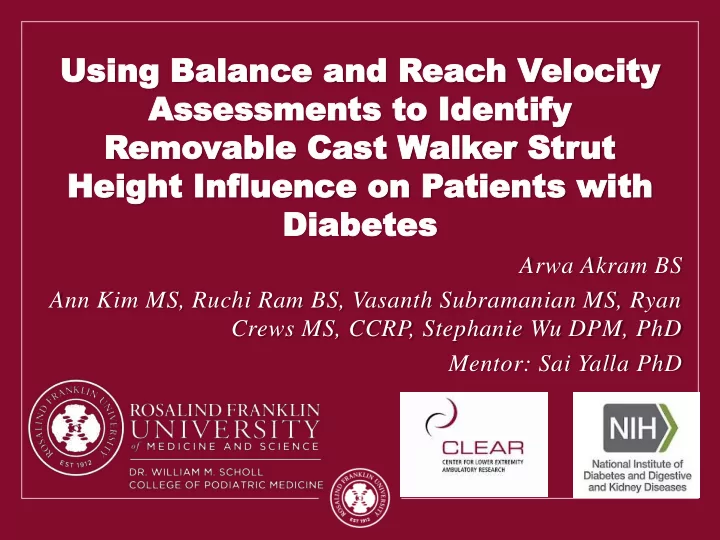

Using Using Balance Balance and R and Reac each V h Velocity elocity Asses Assessmen sments ts to Identify to Identify Remo emova vable ble Cast Cast Walk alker Str er Strut ut Height Height Influence on P Influence on Patient tients s with with Dia Diabetes betes Arwa Akram BS Ann Kim MS, Ruchi Ram BS, Vasanth Subramanian MS, Ryan Crews MS, CCRP, Stephanie Wu DPM, PhD Mentor: Sai Yalla PhD
Disclosure NIH partially supported (2T35DK074390) grant funding from the National Institute of Diabetes and Digestive and Kidney Disease. The content is solely the responsibility of the authors and does not represent the official views of the National Institute of Diabetes and Digestive and Kidney Diseases of the National Institutes of Health.
Introduction • Removable Cast Walkers (RCWs) provide similar offloading capability as Total Contact Casts (TCCs). 1 • Only 27% of diabetic patients actually wear their prescribed offloading devices. 2 • Patient compliance with RCW is directly proportional to wound healing. 1) Boulton, A.J.M., Pressure and the diabetic foot: clinical science and offloading techniques. The American journal of surgery, 2004. 2) Armstrong DG, Lavery LA, Kimbriel HR, Nixon BP, Boulton AJ. Activity patterns of patients with diabetic foot ulceration: patients with active ulceration may not adhere to a standard pressure off-loading regimen. Diabetes Care 2003
Introduction • Postural stability and limb length discrepancy contribute towards reduced compliance of wearing RCWs. • Strut height reduced Ankle-high RCWs could be used alternatively to Knee-high RCWs without compromising offloading functionality. 3 • Functional outcomes and their dependency on strut height are still unknown. 3) Crews, R.T., F. Sayeed, and B. Najafi, Impact of strut height on offloading capacity of removable cast walkers. Clinical Biomechanics, 2012. 27(7): p. 725-730.
Purpose • To assess the impact of offloading Removable Cast Walkers (RCWs) of different strut heights on functional outcomes- • Stability during standing, and reaching • Walking, turning, and sit-to-stand transitions in patients with Type 1 or Type 2 diabetes who are at a moderate to high risk for developing foot ulcerations.
Methods • 21 participants have been recruited for the study. (10M, 11F) Inclusion Criteria : • Diabetic ≥ 35 years with or without wounds • Ability to walk 20 feet without assistive devices Exclusion criteria: • Neurological disorders • Significant musculoskeletal conditions
Methods Standard Shoe Knee High Ankle High Shoe High • High risk foot – RCW, other foot – Standardized shoe • Test of Footwear conditions were randomized • 2 trials conducted for each condition. • 1-2 minutes were provided for acclimatization • Validated wearable sensor technology BalanSens and LEGSys (Biosensics) used for all assessments.
Sliding scale Methods Arrangement Waist Waist sensor sensor Shin Shin sensor sensor Balance assessment Timed up and Go assessment Reach assessment • Modified Rombergs test • • Instrumented using sensors Instrumented functional reach • Eyes open and Eyes closed • • Sit-to-stand, stand-to-sit, walking, truning around FR distance, velocity • COM sway area and • Reciprocal Compensatory Reciprocal Compensatory Index (RCI) media-lateral Index (RCI)
Results • 21 diabetic subjects – average demographics • Age 57 ( ± 9.5) years • Height 169.5 ( ± 12.1) cm • Weight 190.0 ( ± 55.6) lb • Duration of diabetes 11.1 ( ± 7.5) years • Paired two sample t-test and when data did not satisfy normality, Mann-Whitney U test was conducted • Alpha value 0.05, software – IBM SPSS 25
COM Sway Area EO EC 1.8 1 Reciprocal Compensatory Index 0.9 1.6 COM Sway Area (cm 2 ) 0.8 * 1.4 * 0.7 1.2 * 0.6 1 (RCI) 0.5 0.8 0.4 0.6 0.3 0.4 0.2 0.2 0.1 0 0 RK RA RS SS COM sway area with eyes open and closed conditions on the primary axis with Reciprocal Compensatory Index (RCI) on secondary axis for each footwear condition. 10
Functional Reach Distance FR Distance RCI ML FR 12 1.2 Functional Reach Distance (in) 10 1 8 0.8 RCI ML 6 0.6 4 0.4 2 0.2 0 0 RK RA RS SS Functional reach distance on primary axis with Reciprocal Compensatory Index (RCI) on secondary axis for each of the footwear conditions 11
Functional Reach Velocity 0.14 0.12 0.1 Velocity (m/sec) 0.08 * 0.06 0.04 0.02 0 RK RA RS SS Functional Reach velocity for each of the footwear conditions. 12
Timed up and Go Avg S-to-S 6 and stand (sec) times (sec 5 G Sit-st ansition times 4 ge TUG Sit 3 * erage TU transition 2 1 Aver 0 tr RK RA RS SS • Walk duration was lowest (p<0.05) in SS • Compared to RK, RA had significantly (p=0.04) low walk completion time • Turn duration was significantly higher (p=0.01) in RK compared to RA 13
Discussion • Medial-lateral (ML) support by struts seem to improve postural stability while standing. • Rocker bottom RCW combined with lack of ML support resulted in poor stability for Shoe RCW. • Ankle-high RCW seems to strike balance with postural stability, high stability during reaching, low sit-stand time, and better turn around time compared to Knee RCW. • Increasing functional abilities might increase compliance.
Limitations • Small sample size • High power (≥80) was achieved with statistical tests • Only 1 companies RCW was tested • Results should be similar with other RCWs • Only immediate effects were assessed • Study necessitates long-term follow-up RCT studies
Conclusion • Ankle-high RCWs may be the best of the measured devices as there is optimal balance between postural stability and functionality without affecting reach distance and significantly reducing reach velocity. • Ankle-high RCWs may also serve as a great compromise between podiatric physicians who are concerned about proper offloading, patient compliance, and between patients who don’t wear the knee - high RCW due to its uncomfortable nature. • Further studies using ankle-high RCW are warranted to assess patient compliance.
Thank hank you ou
Recommend
More recommend